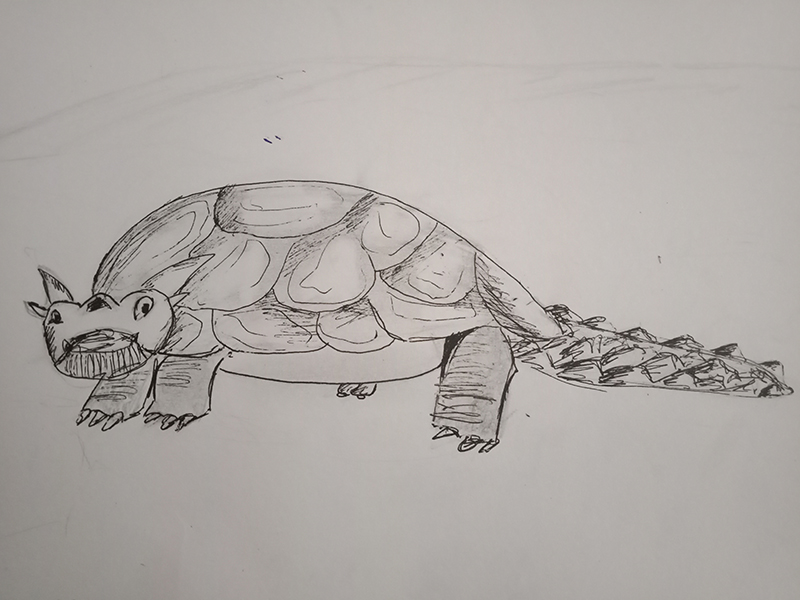Meiolania platyceps Owen, 1886a:315
Lord Howe Island horned turtle
Taxonomy & Nomenclature
Synonym/s: Meiolania minor Owen, 1886b:471; Ceratochelys sthenurus Huxley, 1887:232
Conservation Status
Extinct
Last record: Late Pleistocene
Distribution
Lord Howe Island, New South Wales (& Queensland?), Australia
Biology & Ecology
Hypodigm
AMF 57984
AMF 61110
SMM P76.23.4c
Media

Above: drawing of Meiolania platyceps by Isabell Holmes.
References
Original scientific description:
Owen, Richard. (1886a). Description of fossil remains of two specimens of a Megalanian genus (Meiolania, Ow.), from Lord Howe’s Island. Proceedings of the Royal Society of London 1886(40): 315-316.
Other references:
Anderson, C. (1925). Notes on the extinct Chelonian Meiolania, with a record of a new occurrence. Records of the Australian Museum 14(4): 223-242.
Anderson, C. (1926). The extinct horned turtle Meiolania. The Australian Museum Magazine 2(10): 360-362.
Anderson, C. (1930). Palaeontological notes no. II. Meiolania platyceps Owen and Varanus (Megalania) priscus (Owen). Records of the Australian Museum 17(7): 309-316.
Archer, Michael, Arena, Derrick A. et al. (2006). Current status of species-level representation in faunas from selected fossil localities in the Riversleigh World Heritage Area, northwestern Queensland. Alcheringa, Special Issue 1: 1-17.
Burke, Ann C., Anderson, Michael, Weld, Alison and Gaffney, Eugene S. (1983). The Reconstruction and Casting of a Large Extinct Turtle, [i]Meiolania[/i]. Curator 26(1): 5-25. [Abstract]
Erickson, Bruce R. (2018). History of the Australian Paleontological Collections In The Science Museum of Minnesota (Monograph volume 13: Paleontology). Saint Paul, Minnesota: The Science Museum of Minnesota. 30 pp.
Fletcher, H. O. (1960). Turtles of the past. The Australian Museum Magazine 13(6): 191-195.
Gaffney, Eugene S. (1983). The cranial morphology of the extinct horned turtle, Meiolania platyceps, from the Pleistocene of Lord Howe Island, Australia. Bull. Am. Mus. Nat. Hist. 175: 361-480.
Gaffney, Eugene S. (1985a). The cervical and caudal vertebrae of the cryptodiran turtle, Meiolania platyceps, from the Pleistocene of Lord Howe Island. Am. Mus. Novit. 2805: 1-29.
Gaffney, Eugene S. (1985b). Meiolania platyceps Owen, 1886: The Lord Howe Island Horned Turtle, pp. 132-136. In: Vickers-Rich, Patricia and van Tets, Gerard Frederick. (eds.). Kadimakara: Extinct Vertebrates of Australia. Lilydale, Victoria: Pioneer Design Studio. 284 pp.
Gaffney, Eugene S. (1996). The postcranial morphology of Meiolania platyceps and a review of the Meiolaniidae. Bulletin of the American Museum of Natural History 229: 1-166.
Gaffney, Eugene S. and McNamara, Greg. (1990). A meiolaniid turtle from the Pleistocene of northern Queensland. Memoirs of the Queensland Museum (Proceedings of the De Vis Symposium) 28(1): 107-113.
Holmes, Branden. (2021). What's Lost and What Remains: The Sixth Extinction in 100 Accounts (eBook). Self published.
Hutton, Ian. (1991). Birds of Lord Howe Island: Past and Present. Coffs Harbour Plaza, N.S.W.: Self Published. 154 pp.
Huxley, Thomas Henry. (1887). Preliminary note on the fossil remains of a chelonian reptile, Ceratochelys sthenurus, from Lord Howe’s Island, Australia. Proceedings of the Royal Society, Series B-Biological Sciences 42: 232-238.
Lawver, D. R. and Jackson, F. D. (2014). A review of the fossil record of turtle reproduction: eggs, embryos, nests and copulating pairs. Bulletin of the Peabody Museum of Natural History 55(2): 215-236.
Lichtig, Asher J. and Lucas, Spencer G. (2018). The ecology of Meiolania platyceps, a Pleistocene turtle from Australia. New Mexico Museum of Natural History and Science Bulletin 79: 363-368.
McNamara, G. C. (1990). The Wyandotte Local Fauna: A new, dated, Pleistocene vertebrate fauna from Queensland. Memoirs of the Queensland Museum (Proceedings of the De Vis symposium) 28(1): 285-297. [Meiolania sp. cf. M. platyceps]
Mittermeier, Russell A. (1972). Zoogeography of Fossil and Living Turtles. Australian Natural History 17(8): 265-269.
Owen, Richard. (1880). Description of some remains of the gigantic land-lizard ([i]Megalania prisca[/i] Owen) from Australia. Part II. Phil. Trans. R. Soc. [b]171[/b]: 1037-1049. [includes fossil material now known to belong to M. platyceps]
Owen, Richard. (1886b). Description of fossil remains of two species of a megalanian genus (Meiolania) from ‘Lord Howe’s Island’. Philosophical Transactions of the Royal Society of London 177: 471-480.
Owen, Richard. (1888). On parts of the skeleton of Meiolania platyceps (Ow.). Philosophical Transactions of the Royal Society of London 179: 181-191.
Quirk, Susan and Archer, Michael (eds.), with Schouten, Peter (illustrator). (1983). Prehistoric animals of Australia. Sydney: Australian Museum. 80 pp.
Squires. D. F. (1963). Carbon-14 dating of the fossil dune sequence. Lord Howe Is. Austr. J. Sci. 25. 412-3. 1963.
Sterli, J. (2015). A review of the fossil record of Gondwanan turtles of the clade Meiolaniformes: Bulletin of the Peabody Museum of Natural History 56: 21-45.
Sutherland, Lin and Ritchie, Alex. (1974). Defunct volcanoes and extinct horned turtles. Australian Natural History 18(2): 44-49.
Sutherland, Lin and Ritchie, Alex. (1977). Defunct volcanoes and extinct horned turtles. Pages 7-12 in Lord Howe Island. Published by the Australian Museum, Sydney.
Thorn, Kailah M., Poropat, Stephen F., Bell, Phil R., Hocknull, Scott A., Kear, Bejamin P., Palci, Alessandro, Salisbury, Steven W. and Yates, Adam M. (2021). Checklist of the fossil reptile and amphibian species of Australia. Available from: https://www.australasianpalaeontologists.com/national-fossil-species-lists [Accessed 24 November 2024]
Turtle Extinctions Working Group et al. (2015). Turtles and Tortoises of the World During the Rise and Global Spread of Humanity: First Checklist and Review of Extinct Pleistocene and Holocene Chelonians. Chelonian Research Monographs No. 5: 1-66.
White, A. W. et al. (2010). Megafaunal meiolaniid horned turtles survived until early human settlement in Vanuatu, Southwest Pacific. PNAS (Proceedings of the National Academy of Sciences) 107(41): 15512-15516.
http://extinctanimals.proboards.com/thread/9030/meiolania-platyceps
